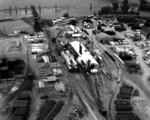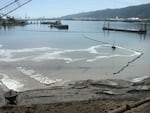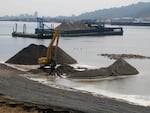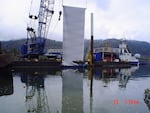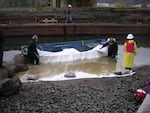
A creosote sheen from the McCormick & Baxter site stretches into the Willamette River in 2004.
Oregon Department of Environmental Quality
PORTLAND -- Decades of pollution have made the Willamette River a laboratory for environmental cleanup.
Take the McCormick & Baxter Superfund Cleanup site, where as much as 2 million gallons of creosote used to treat lumber have soaked the shore and gummed up the river sediment. It was there in 2004 and 2005 that an old product with great environmental promise -- organophilic clay -- was used in a new way: under water instead of on land. And the experiment appears to have worked.
"The McCormick & Baxter site was the first time it had been used on any appreciable scale in water to protect sediment. But since then, as a result of the success at McCormick & Baxter, it has been used elsewhere," says University of Texas engineering professor Danny Reible.
The organophilic clay begins as a clay that naturally absorbs water. Then, after it is tinkered with, it rejects water but becomes a mop for oily materials, such as the creosote, says Reible, who directs the university's Center for Research in Water Resources.
Before the Portland Harbor project, the clay had been used extensively in the oil and gas industry to soak up drilling byproducts, says Tony Brown, president of Aqua Technologies of Wyoming, a developer of the oil-loving product.
The company worked 90 days around the clock to produce more than 1 million pounds of the special clay for the McCormick & Baxter project, Brown says.
Brown's company shipped the product in 1,500-pound bags that opened from the bottom. That allowed the cleanup crews to lower the bags into the water to about a foot above the sediment, open the bottom chute and dump the clay, which settled on the bottom.
(Photo: Oregon Department of Environmental Quality)
Crews created a sediment cap that covered about 23 acres of river sediment. They dumped a 2-foot layer of sand in some places and a 5-foot layer of sand in others before topping that with the organophilic clay, according to the DEQ's 2006 report on the site.
The underwater cap was completed with a layer of rocks, says Scott Manzano, the site's manager for Oregon's Department of Environmental Quality.
Later, layers of fiber embedded with organophilic clay also were placed in several areas.
The blankets were kind of like layered cookies, Manzano says.
To date, sampling at the McCormick & Baxter site shows that the capping on the banks and in the river is controlling the creosote, which would have been financially prohibitive to remove.
"If you look back at the site 10 to 15 years ago, there were seeps of creosote throughout the site. You could see evidence of the past activities of the site all around the edge of the river, and now you don't see any evidence of that. You don't see the sheen. You don't see the creosote coming to the surface," Reible says.
McCormick and Baxter filed bankruptcy in 1989 after spending about 50 years treating lumber. It left behind a legacy of thick creosote, copper, chromium, zinc, arsenic, PCPs and other contaminants.
The success of the clay capping here, and again later in Washington D.C.'s Anacostia River, has led to similar pollution containment strategies in places such as the heavily polluted Grand Calumet River near Chicago.
Organophilic clay also has been used in the water at the Port of Portland Terminal 4 cleanup site.
Officials select pollution treatments based on minimizing explosure risks and on costs, Manzano says.
